The Dell XPS 13 (9300) Review: Return of the King
by Brett Howse on July 16, 2020 10:00 AM ESTBattery Life
One area that the XPS line has historically done very well was in battery life. This has been a combination of Dell building very efficient devices, as well as providing above-average battery capacities. For the 2020 XPS 13, Dell is offering a 52 Wh battery, which is somewhat smaller than they have in previous models. We shall see what kind of an impact that has on the overall runtime of this notebook. To fairly compare models, all devices are tested with the display brightness set to 200 nits.
Web Battery Life
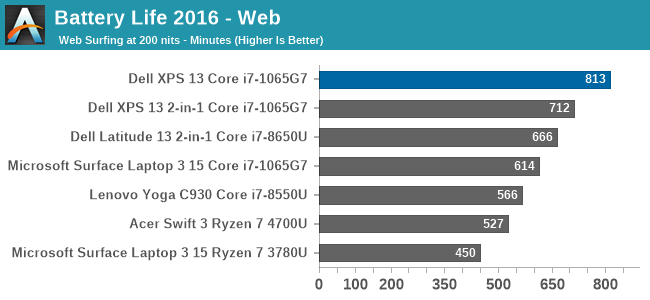
Dell starts out strong with an excellent result on our web battery life test. It managed to achieve over 13.5 hours of runtime on this fairly demanding web workload.

The normalized result removes the battery size from the equation so we can get a clearer picture on overall device efficiency, and we can see why the XPS 13 has lost none of its amazing battery life despite Dell shrinking the battery capacity. Dell continues to lead the field here, at least with the 1920x1200 display that we reviewed. Certainly the higher-resolution, wide-gamut 3840x2400 panel would impact this result significantly.
PCMark 10 Modern Office Battery
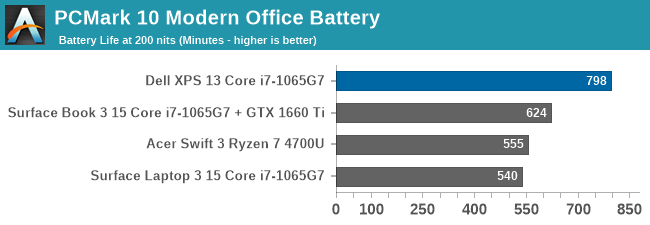
A new benchmark added to the stable is the PCMark 10 Modern Office Battery test, which runs through several common office scenarios on a ten-minute loop. If a device is able to finish the tasks quicker, it gets to idle for a higher percentage of the ten-minute test loop, so efficiency is important, but performance also plays a factor. The XPS 13 once again achieved a very strong result, almost matching the web runtime.
Movie Playback
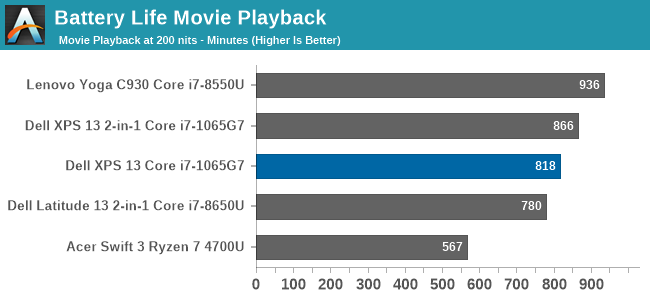
On the movie playback we generally see devices offer even more battery life than the other tests, but the XPS 13 showed such platform efficiency in the previous results that it was not able to extend that much here, but it is still a very strong result.
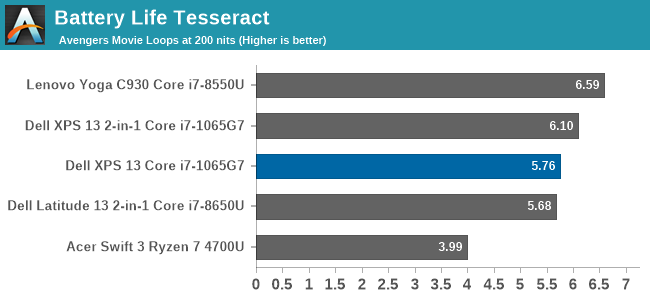
Breaking the movie playback into number of times you can play a very long movie, the XPS 13 almost achieves six complete playbacks of The Avengers before shutting down.
Charge Time
Dell ships a 45-Watt AC adapter with the XPS 13, which charges over a USB-C connector. Since there are Thunderbolt 3 ports on both sides of the notebook, it allows you to charge from whatever side is most convenient, which can help with cable management and is always a nice bonus.
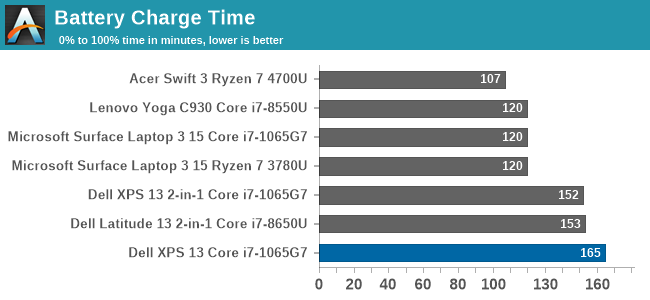
The small charger is plenty to run the notebook, but the charge rate is not spectacular. Luckily, the excellent battery life does mitigate this. Dell does offer an ExpressCharge option which will charge the battery to 80% in one hour and fully charge in two hours, however the user has to specifically choose this if they desire it using the Dell Power Manager software.










224 Comments
View All Comments
grant3 - Friday, July 17, 2020 - link
USB-A is sometimes useful sure, but aside from old flash drives, what do you -need- it for?Just spend the $30 on some USB-C cables to replace your USB-A cables. Yes it's in many ways a needless expense, but it can be justified as a minor price bump for people who are already spending $1400+ on a new laptop.
yeeeeman - Thursday, July 16, 2020 - link
Tigerlake has a lot of things to fix...Sahrin - Thursday, July 16, 2020 - link
No Ryzen 4000 series; it's obsolete on launch day.roldaxc - Thursday, July 16, 2020 - link
Soldered SSD? only two Type-C ports? Just get an X1 Carbon. All around a much more solid laptop, more reliable, much better keyboard, lots of ports and similar footprint.I wonder why it's not included in the device comparison in this article..
iq100 - Thursday, July 16, 2020 - link
I would never buy a Dell product.When the XPS 15 9560 was purchased with on site service, it took six attempts to get it to work.
Here are the parts replaced on just the last (sixth) attempt.
SERVICE REPORT
REPLACEMENT PARTS
No. Dell Part QTY Description Parts Retained by Customer
1 5R1JP 1 ASSY,CVR,BTM,W/BDG,9550 No
2 M0T6P 1 ASSY,PLMRST,W/FPR,80,9560 No
3 9TXK7 1 ADPT,AC,130W,DLTA,4.5,L6,V2,E5 No
4 RN699 1 ADPT,CON,VID,DNGL,DP2VGA,L No
5 64TM0 1 ASSY,CBL,DC-IN, 9550/5510 No
6 2JVNJ 1 CORD,PWR,125V,2.5A,1M,C5,E5,US No
7 5G0HC 1 ASSY,PWA,DTRBD,AUDIO,9560/5520 No
Old wounds, not healed only fester. I purchase two U3011s. Both suffered the same design defect. Dell replace one but NOT the other, claiming "it was their policy to replace only one". Go figure.
www.tinyurl.com/HellIsDell
svan1971 - Thursday, July 16, 2020 - link
The only thing it's missing is a Ryzen cpu as far as I can tell.lmcd - Thursday, July 16, 2020 - link
Every comment thread is AMD vs Intel. I'm here to represent VIA's amazing Nano product line featuring Isaiah cores. Fight the power. Pick VIA.Honestly dunno why everyone is screaming for retroactive design wins. That's just not how it works.
Jorgp2 - Thursday, July 16, 2020 - link
Especially since AMD seems to count gaming laptops and their many products on the same chassis.What's the point of having more design wins, if those designs push fewer units.
Spunjji - Friday, July 17, 2020 - link
You should really ask the people making the designs. They're the ones shooting their own products in the foot, year after year.Spunjji - Friday, July 17, 2020 - link
Of course that's not how it works, but that's a straw man.According to the habitual Intel stans on this page:
You can't expect AMD designs when AMD has markedly inferior products and Intel is executing well.
You can't expect AMD designs when AMD have released broadly competitive products and Intel has been executing poorly for a couple of years with no signs of improving any time soon.
You can't expect AMD designs when AMD have released markedly superior products and Intel have been dropping the ball for 4 years straight but will maybe have a competitive product *soon*.
So the question is: when can we ever expect AMD designs to be developed? When do we finally get the competition needed to keep prices reasonable on high-end products?
The answer you're giving is "I'm fine with never", which means your opinion isn't worth shit.